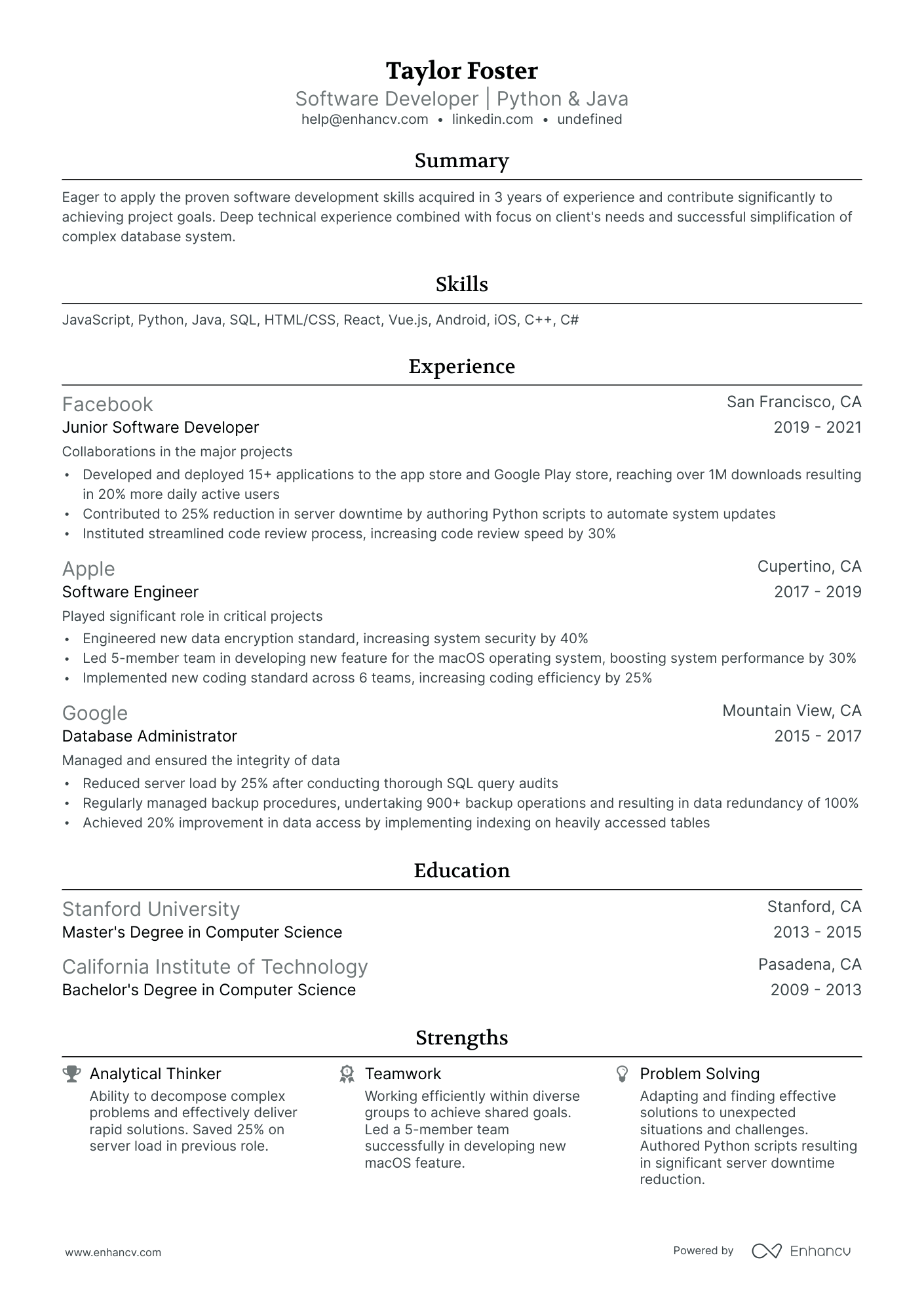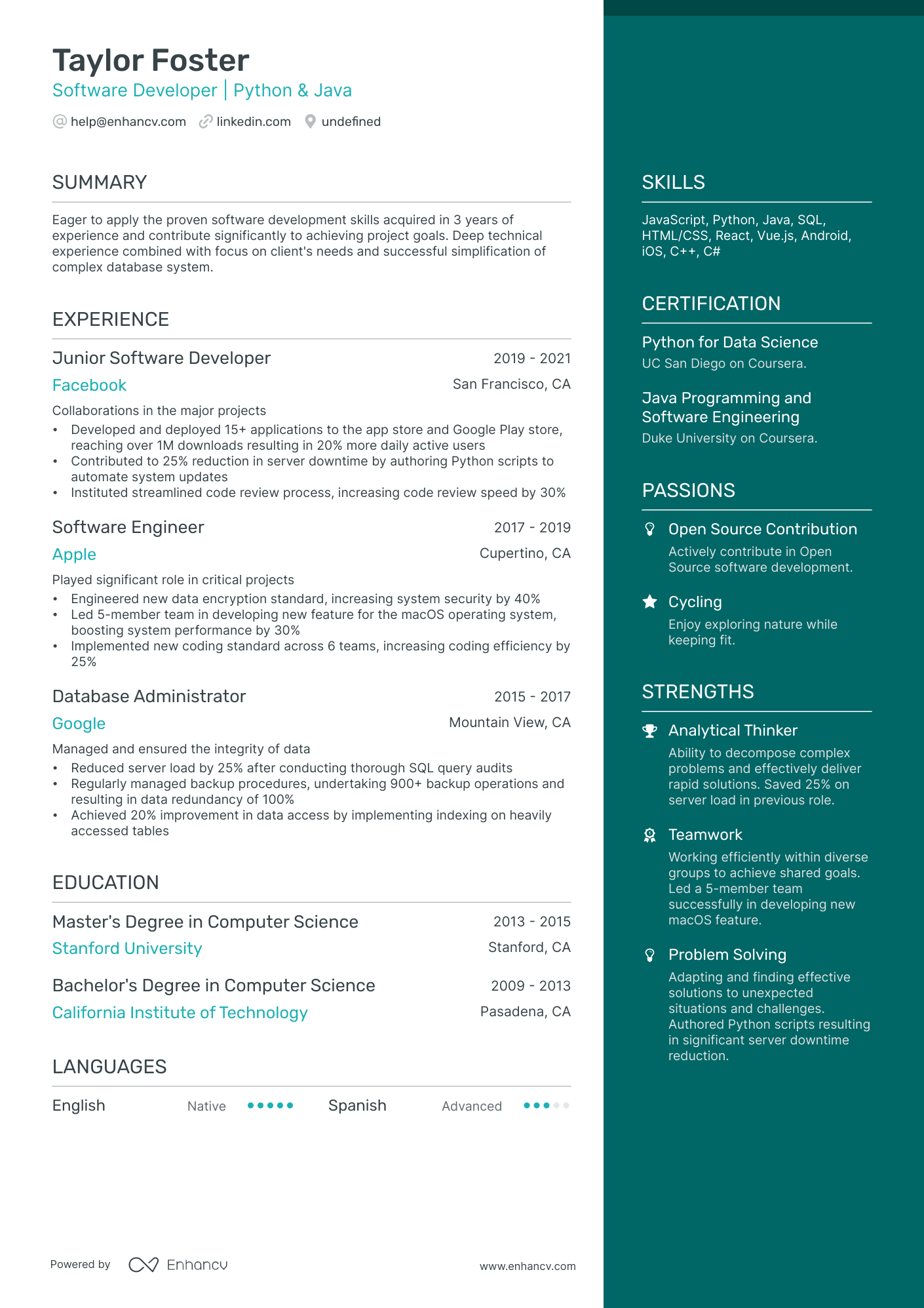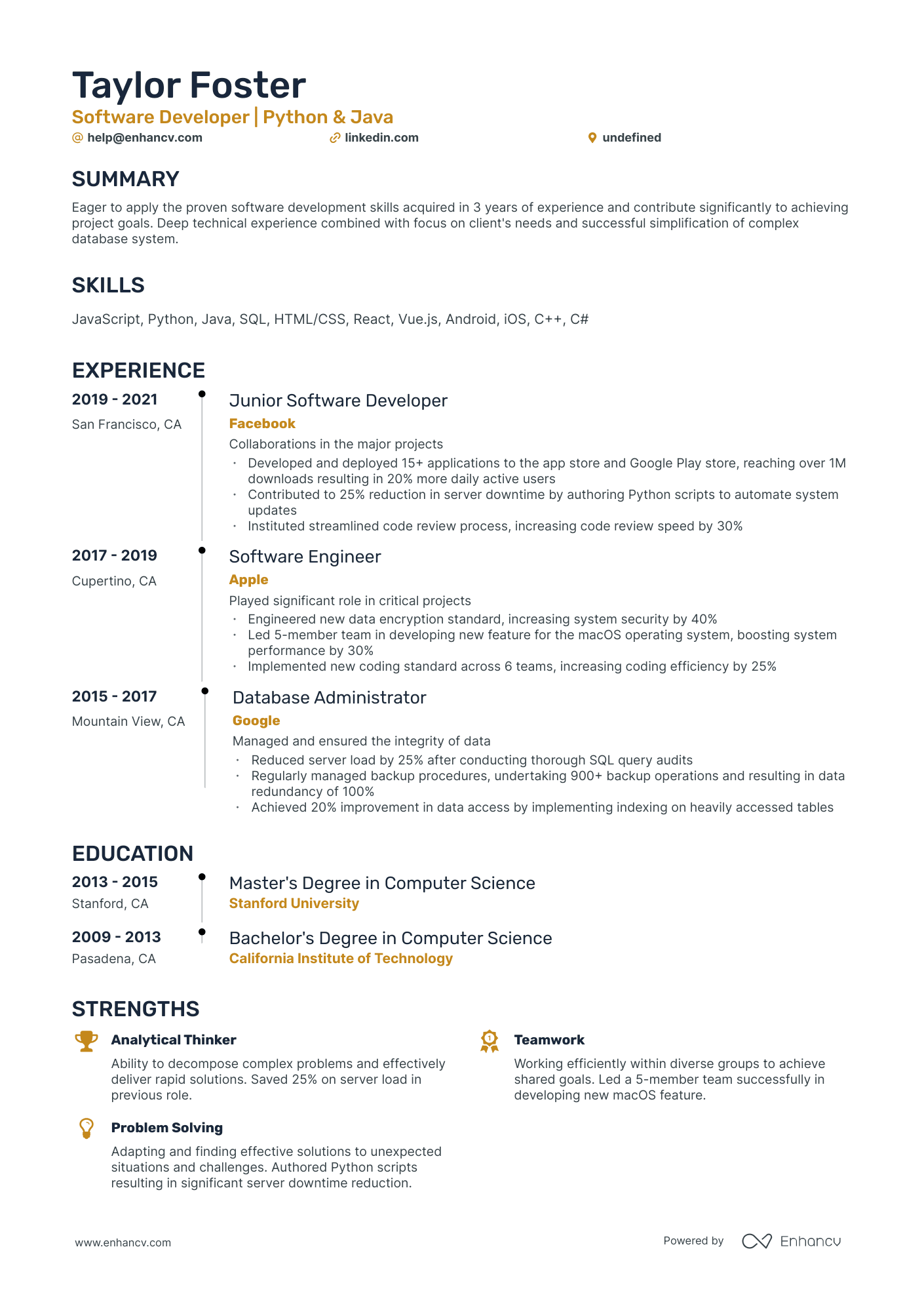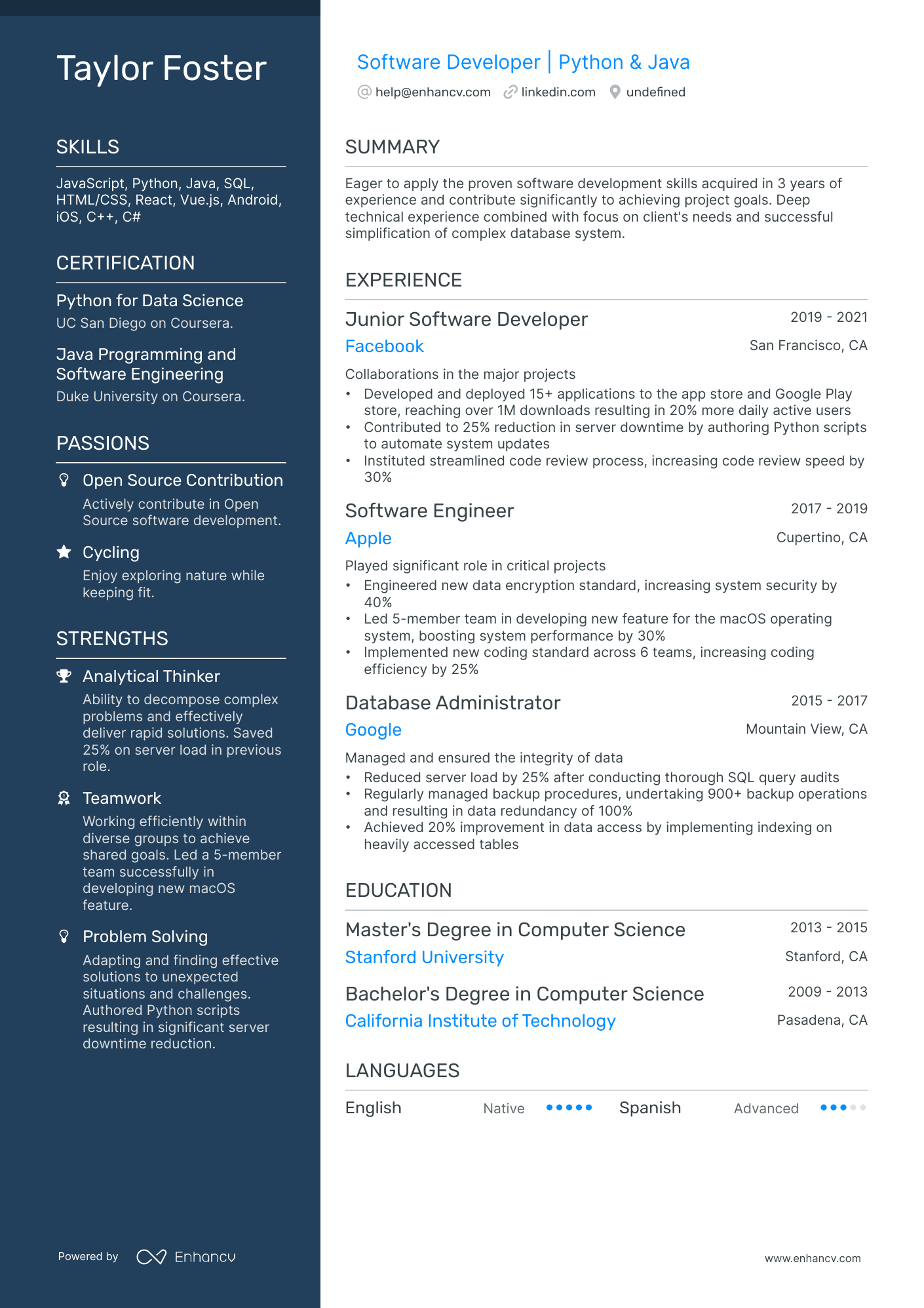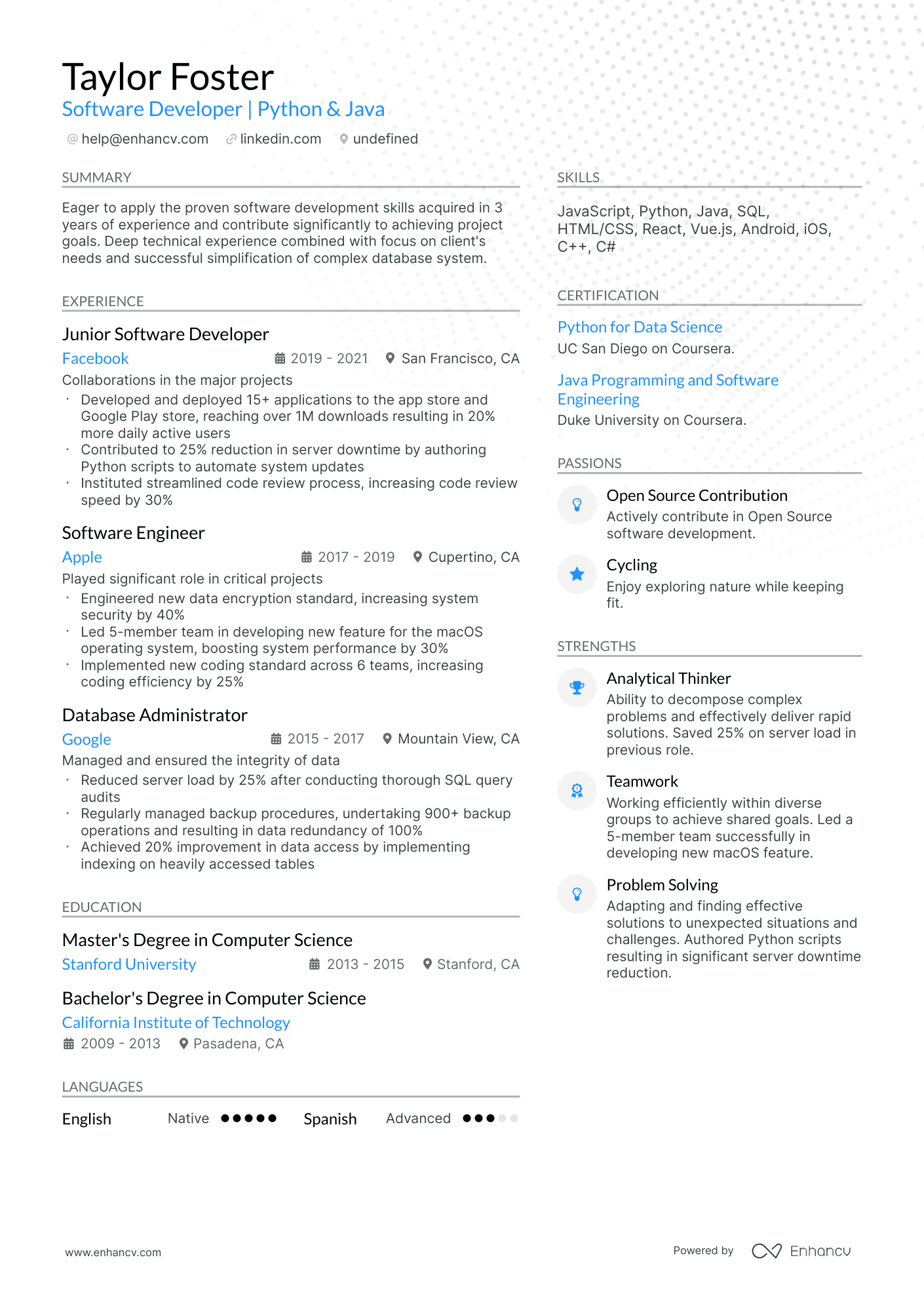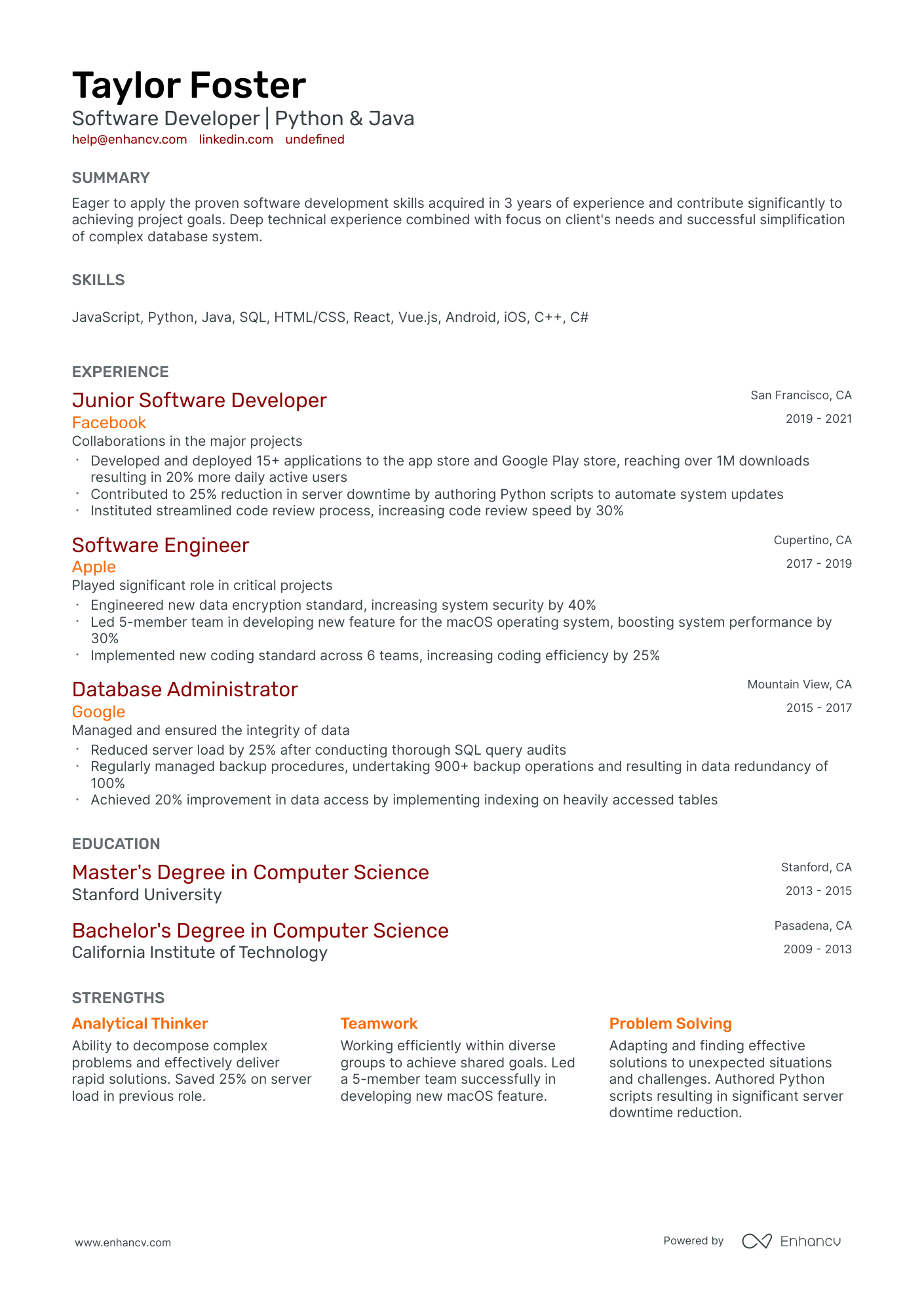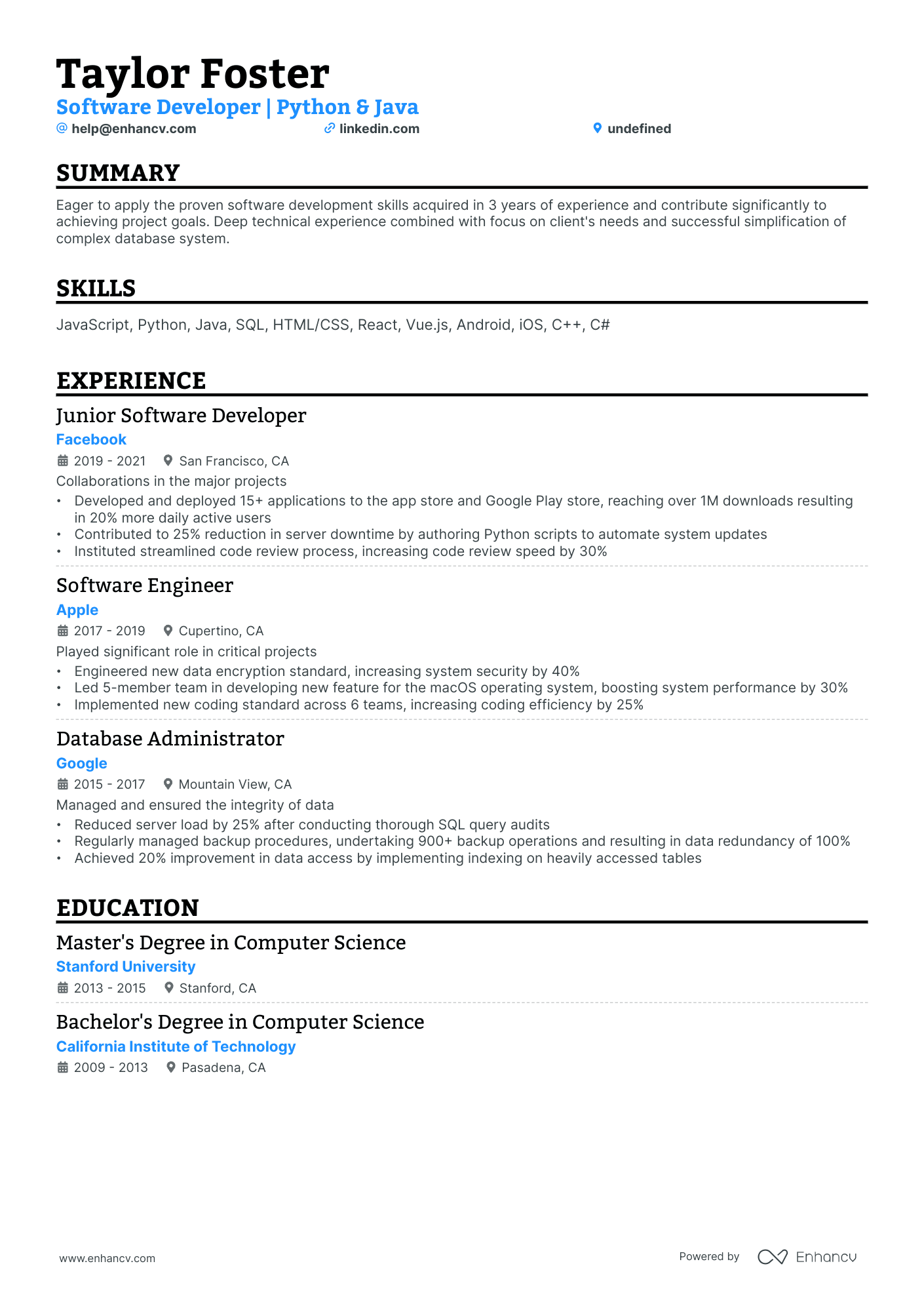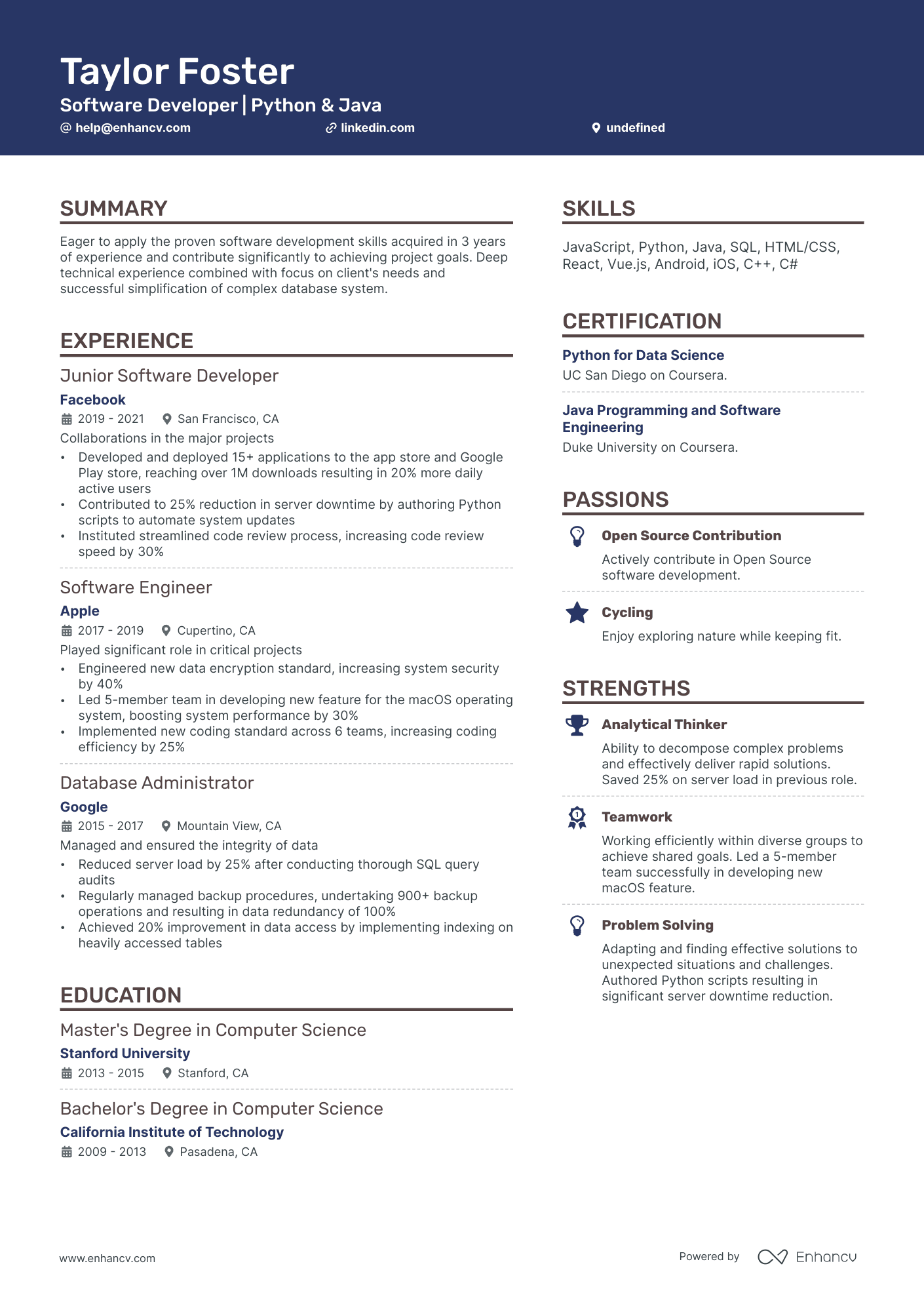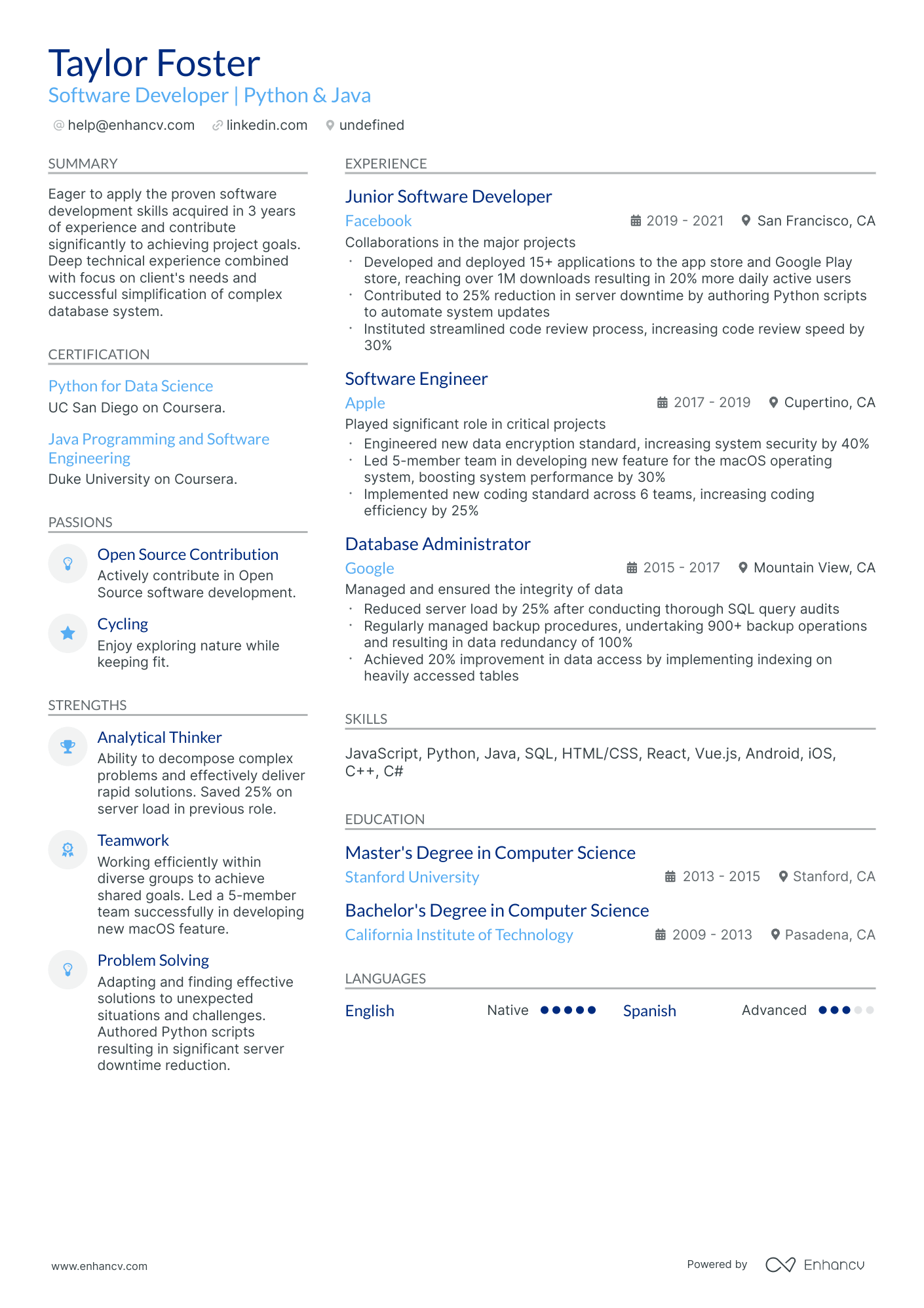Entry-level computer science candidates often struggle to showcase their skills and experiences effectively, due to the lack of substantial professional work history. Our guide can assist by providing tailored strategies to highlight academic projects, relevant coursework, skills, and internships, transforming these elements into convincing evidence of your potential in a computing career.
Dive into this guide to uncover:
- Top-tier entry-level computer science resume samples that have successfully landed candidates in leading companies.
- Strategies to direct recruiters' focus towards your standout experiences, notable achievements, and pivotal skills.
- Guidance on crafting resume sections that align closely with the vast majority of job specifications.
- Insights on harmonizing your entry-level computer science technical prowess with your distinct personality, setting you apart from the competition.
Recommended reads:
Simple guide to your entry-level computer science resume format
Successful entry-level computer science resumes all have something in common - candidates invest in a simple resume layout . One that is easy to read, makes a good first impression, and is adapted to their professional experience.
There are three distinct resume formats , which help you focus on different aspects of your resume. Those are:
- A reverse-chronological resume format - puts your most recent experience in the spotlight
- A functional skill-based resume format that makes your transferrable skills the center of attention
- A hybrid resume format - it combines skills and experiences.
What's more, keep in mind that your resume usually goes through an ATS (Applicant Tracker System) (i.e. the software used by companies in the hiring process).
The entry-level computer science resumes that suit the ATS:
- incorporate exact match keywords and skills from the job description;
- should be no longer than two pages;
- should be submitted in a PDF format, unless specified otherwise.
Upload your resume
Drop your resume here or choose a file. PDF & DOCX only. Max 2MB file size.
Pro tip
At the end of the day, recruiters care most about how easily they can scan and read your resume layout. Unless you're aiming for a role in a creative field, it might be best to stick with a straightforward layout and format. Instead, put your energy into showcasing your experience.
Elevate your senior data scientist resume with these essential sections:
- Header: The go-to section for recruiters seeking your contact details, portfolio, or current role.
- Summary or objective: A snapshot of your achievements and aspirations.
- Experience: A testament to your technical and interpersonal prowess.
- Skills: A showcase of your capabilities aligned with the job requirements.
- Certifications/Education: A reflection of your commitment to staying updated in the industry.
What recruiters want to see on your resume:
- Relevant Education: An undergraduate degree or coursework in computer science or a related field.
- Technical Skills: Proficiency in languages such as Python, Java, C++, SQL and knowledge of software development methodologies, data structures, algorithms, and computer architecture.
- Internship Experience or Projects: Hands-on experience gained through internships or class projects related to the field.
- Certifications: Any relevant certifications such as certified solutions architect from AWS or professional certification in machine learning.
- Problem-Solving Abilities: Demonstrated ability to solve complex problems, often showcased through participation in coding competitions or hackathons.
Recommended reads:
Guide to your most impressive entry-level computer science resume experience section
When it comes to your resume experience, stick to these simple, yet effective five steps:
- Show how your experience is relevant by including your responsibility, skill used, and outcome/-s;
- Use individual bullets to answer how your experience aligns with the job requirements;
- Think of a way to demonstrate the tangible results of your success with stats, numbers, and/or percentages ;
- Always tailor the experience section to the entry-level computer science role you're applying for - this may sometimes include taking out irrelevant experience items;
- Highlight your best (and most relevant) achievements towards the top of each experience bullet.
You're not alone if you're struggling with curating your experience section. That's why we've prepared some professional, real-life entry-level computer science resume samples to show how to best write your experience section (and more).
- Developed and maintained web applications using HTML, CSS, and JavaScript resulting in improved user experience and increased site traffic by 30%.
- Collaborated with cross-functional teams to design and implement database solutions for efficient data management, reducing query response time by 40%.
- Implemented machine learning algorithms for sentiment analysis, leading to a 20% increase in customer satisfaction scores.
- Streamlined software testing processes by implementing automated test scripts, reducing testing time by 50%.
- Participated in Agile development methodologies, contributing to on-time project delivery and successful product launches.
- Designed and developed mobile applications for Android platform, resulting in over 100,000 downloads and a 4-star rating on app stores.
- Performed code reviews and debugging, identifying and fixing critical issues, resulting in a 30% reduction in application crashes.
- Collaborated with UX/UI designers to create intuitive and visually appealing interfaces, leading to a 25% increase in user engagement.
- Optimized application performance by implementing caching mechanisms, reducing loading time by 50%.
- Implemented push notification functionality, resulting in a 40% increase in user retention rate.
- Managed end-to-end software development lifecycle, overseeing a team of developers and ensuring timely project delivery.
- Led the migration of legacy systems to a cloud-based infrastructure, resulting in improved scalability and cost savings of over $100,000 annually.
- Developed RESTful APIs for seamless integration with external systems, enhancing data exchange capabilities and enabling third-party integrations.
- Implemented automated deployment and continuous integration processes, reducing deployment time by 60%.
- Collaborated with product managers to define and prioritize features, resulting in a 20% increase in customer satisfaction.
- Designed and implemented database schemas, optimizing data storage and retrieval operations, resulting in a 50% reduction in query execution time.
- Developed scalable web applications using Java and Spring framework, handling concurrent user requests and improving system responsiveness.
- Collaborated with UI/UX designers to create intuitive user interfaces, leading to a 40% increase in user engagement.
- Integrated payment gateways and implemented secure transaction processing, resulting in a 30% increase in successful transactions.
- Participated in code refactoring and performance optimization efforts, resulting in a 25% improvement in application response time.
- Developed and deployed scalable microservices architecture using Docker and Kubernetes, improving system availability and reducing downtime by 40%.
- Implemented real-time data processing pipelines using Apache Kafka, enabling faster analytics and decision-making processes.
- Collaborated with data scientists to develop machine learning models for predictive analysis, resulting in a 15% increase in sales revenue.
- Designed and implemented RESTful APIs for seamless integration with external systems, enabling secure data exchange and third-party integrations.
- Performed code reviews and conducted regular performance testing, identifying and resolving bottlenecks, resulting in a 20% improvement in system performance.
- Developed front-end interfaces using JavaScript frameworks like React and Angular, resulting in improved user experience and increased user retention by 35%.
- Collaborated with UX designers to create wireframes and prototypes, facilitating user-centered design and iterative development processes.
- Implemented RESTful APIs and integrated with backend services, enabling seamless data flow between the client and server.
- Optimized website performance by implementing caching mechanisms and lazy loading techniques, reducing page load time by 50%.
- Participated in code refactoring and quality assurance activities, resulting in improved code maintainability and reduced bug count by 30%.
- Designed and developed scalable distributed systems using Hadoop and Apache Spark, ensuring efficient processing of large volumes of data.
- Implemented data transformation and cleansing pipelines, resulting in improved data accuracy and completeness.
- Collaborated with data scientists to implement machine learning algorithms for anomaly detection, resulting in a 25% reduction in fraud cases.
- Optimized SQL queries and performed database performance tuning, reducing query response time by 40%.
- Participated in Agile development methodologies, contributing to on-time project delivery and successful data product launches.
- Developed and maintained backend services using Python and Django framework, ensuring reliable and secure data processing.
- Collaborated with frontend developers to design APIs and implement robust data exchange mechanisms, resulting in improved system interoperability.
- Performed database administration tasks, including schema design, backup and recovery, and performance optimization.
- Implemented authentication and authorization mechanisms, enhancing system security and protecting sensitive user information.
- Participated in code reviews and conducted unit testing, ensuring high-quality code and reducing bug count by 30%.
- Developed and maintained e-commerce platforms using PHP and Magento, resulting in a 20% increase in online sales revenue.
- Collaborated with UI/UX designers to create visually appealing and user-friendly interfaces, leading to a 30% decrease in bounce rate.
- Implemented payment gateway integrations and secure transaction processing, ensuring smooth and secure online transactions.
- Optimized website performance by implementing caching mechanisms and server-side rendering, reducing page load time by 50%.
- Participated in Agile development methodologies, contributing to on-time project delivery and successful product launches.
- Designed and developed scalable cloud-based applications using AWS services, ensuring high availability and fault tolerance.
- Collaborated with DevOps engineers to establish CI/CD pipelines, enabling automated deployment and seamless release cycles.
- Implemented serverless architecture using AWS Lambda, resulting in significant cost savings and improved scalability.
- Optimized application performance by leveraging caching mechanisms and distributed computing technologies.
- Participated in code reviews and conducted regular security audits, ensuring adherence to industry best practices and data protection regulations.
Quantifying impact on your resume
<ul>
Writing your entry-level computer science experience section without any real-world experience
Professionals, lacking experience, here's how to kick-start your entry-level computer science career:
- Substitute experience with relevant knowledge and skills, vital for the entry-level computer science role
- Highlight any relevant certifications and education - to showcase that you have the relevant technical training for the job
- Definitely include a professional portfolio of your work so far that could include university projects or ones you've done in your free time
- Have a big focus on your transferable skills to answer what further value you'd bring about as a candidate for the entry-level computer science job
- Include an objective to highlight how you see your professional growth, as part of the company
Recommended reads:
Pro tip
Boost your resume by focusing on the practical aspects of each job requirement. While it's good to have job-related keywords on your resume, ensure they're backed by action verbs and quantifiable data. This gives recruiters a clear picture of your entry-level computer science professional journey.
Entry-level computer science resume skills: showcasing both hard and soft skills
Your entry-level computer science resume should show recruiters your range of skills. List the tools and software you use (hard skills) and how they fit into your daily tasks. But don't stop there. Share the personal traits (soft skills) you've gained from your experiences. Here's how:
- Showcase three top career achievements.
- For each achievement, mention a hard and a soft skill you used.
- Highlight unique skills that set you apart.
- Discuss how your skills improved the workplace or team culture.
Check our list for popular hard and soft skills in the industry.
Top skills for your entry-level computer science resume:
Python
Java
JavaScript
HTML/CSS
SQL
Git
Linux
C++
Data Structures
Basic Algorithms
Problem Solving
Teamwork
Communication
Time Management
Adaptability
Critical Thinking
Attention to Detail
Creativity
Work Ethic
Eagerness to Learn
Pro tip
Don't go all over the place with your skills section by listing all keywords/ buzzwords you see within the ad. Curate both hard and soft skills that are specific to your professional experience and help you stand out.
Optimizing the education and certification sections of your entry-level computer science resume
Your education and certification sections can be game-changers on your entry-level computer science resume, showcasing your commitment to professional growth.
For the education section:
- Highlight advanced education, noting the institution and duration.
- If you're currently studying, mention your expected graduation date.
- Exclude degrees that don't align with the job's requirements.
- If relevant, delve into your academic journey, spotlighting significant achievements.
When listing degrees and certifications:
- Feature those directly relevant to the role.
- Highlight recent and significant knowledge or certifications at the top of your resume.
- Provide essential details like the issuing institution and dates for credibility.
- Avoid listing irrelevant degrees or certifications, such as your high school diploma or unrelated specializations.
Remember, even if you're tempted to omit your education or certifications, they can offer a competitive edge, signaling a long-term commitment to the industry.
Best certifications to list on your resume
Pro tip
The reputation of the institution or organization granting your certification or degree can bolster your credibility. Prioritize recognized and respected credentials.
Recommended reads:
Best practices for your entry-level computer science resume summary or objective
How do you know if you should include a resume summary or a resume objective?
- Resume summaries are ideal for entry-level computer science professionals with more experience, who'd like to give a quick glimpse of their biggest career achievements in the top one-third of their resumes.
- On the other hand, resume objectives serve as a road map to the applicant's aspirations. Candidates use the objective as the North Star of their career (or, how they see themselves in the role in the next few years).
Both could be the perfect fit for your entry-level computer science resume, depending on your experience.
Here's how candidates for the entry-level computer science job structure their summaries and objectives.
Resume summary and objective examples for a entry-level computer science resume
Additional sections to elevate your entry-level computer science resume
Recruiters often seek candidates who offer more than just the basics.
To stand out, consider adding:
- Interests: Share hobbies or activities that reveal your personality and transferable skills.
- Projects: Highlight innovative work that showcases your expertise.
- Languages: If communication is vital for the role, showcase your linguistic abilities.
- Awards: Feature significant recognitions that underscore your expertise.
Key takeaways
- Pay special attention to the tiny details that make up your entry-level computer science resume formatting: the more tailored your application to the role is, the better your chances at success would be;
- Select the sections you include (summary or objective, etc.) and formatting (reverse-chronological, hybrid, etc.) based on your experience level;
- Select experience items and, consequently, achievements that showcase you in the best light and are relevant to the job;
- Your profile will be assessed both based on your technical capabilities and personality skills - curate those through your resume;
- Certifications and education showcase your dedication to the particular industry.
